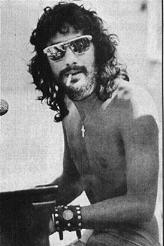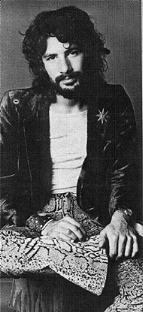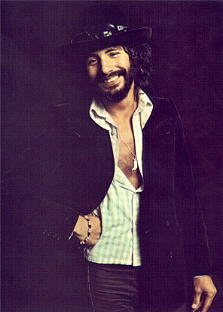Cat Stevens appeared on only two covers of Circus Magazine. Though he
appeared on the cover of this magazine, this is not what I would call a great
article. This article amoung other publications, is probably one of the
reasons, Cat Stevens never really liked to be interviewed for music magazines.
Cat
Stevens

- Retreat
- From The Sting
- Of Applause
After twelve months holed up
in his London house, Cat Stevens has finally come back with a new LP and a new tour. But
the LP has only made his reasons for seclusion seem twice as tantalizing, twice as
enigmatic.
By Michele Hush
Photos: Chuck
Pulin
This madness is fine
Yes, it you’re mad at the
time
"Freezing Steel"
by Cat Stevens (1972)
It was a cool, breezy
afternoon in late summer and Cat Stevens’ British manager, Barry Krost, was relaxing
over an Italian lunch in a mid-Manhattan restaurant. He talked about anything and
everything except Cat Stevens right through his shrimp cocktail and well into his
manicotti. After an hour or so, he reached into his pocket and pulled out a sheet of paper
which turned out to be the itinerary for the Cat Stevens fall tour of the U.S., and then
delivered a sort of "News of the Week in Review"—a summary of the upcoming
tour, of the new album Catch Bull At Four and of an upcoming Teaser and the Firecat book
and cartoon. By the time the dessert cart arrived all pertinent information had been
exhausted, so Barry sighed with relief and wandered into a strange soliloquy about the odd
relationship he enjoys with his client. He admitted that they often don’t speak to
each other for weeks at a time, and you began to wonder if he really knows the guy.
Finally, right in the middle of his fruit salad, he confided, "You know, I think
Steve is going to grow up to be a great composer."
Twelve-month
silence: Cat Stevens may be acting like an embryonic Beethoven in private, but in
public he has seemed much more like the Invisible Man. For the better part of a year, the
Cat remained fastidiously out of the public eye, safely away from the press and fans
alike. No performances, no records, no interviews, no nothing. This month he finally broke
open the first crack in his long, vacuous silence with a 30-day tour and a new album (on
A&M Records), an album that he actually recorded in London over six months ago. But
instead of clearing up the question of the dark-eyed singer’s private movements.
Catch Bull At Four has only
made those movements seem twice as tantalizing, twice as enigmatic. The songs range from
almost medieval ballads like "The Boy With The Moon And Stars In His Hair" (a
tale of a superchild born from a casual rendezvous between a bride-groom-to-be and a
strange woman) to frenzied near-rockers like "Sitting," which hint that Steve
has grown morc frustrated, yet more determined:
 Oh,
I’m on my way, I know I am Oh,
I’m on my way, I know I am - But times there were when I
thought not
- Bleeding half my soul in bad
company
- I thank the moon I had the
strength to stop
- Just keep pushing hard, boy, Try
as you may
- You’re gonna wind up where
you started from
What’s more, Steve has
made a sudden change from simple accompaniment to the use of a synthesizer and a crowd of
violins (which, incidentally’ he’s brought along on his tour). It all seems
vaguely mysterious; yet over his manicotti, manager Barry Krost had declared with evasive
charm that Cat Stevens hasn’t been hiding, but merely "taking it slow."
Considering his past, however, Cat Stevens could be a man with plenty of reasons to hide.
Logically, the search for clues to his recent Seclusion begins in that past.
From goof-off to
heart-throb: The early history of Steven Demitri Giorgiou is pretty familiar
territory at this point, but we’ll run through it briefly for the benefit of anyone
who has somehow missed it. Biologically he’s a mongrel-—born in England to a
Swedish mother and a Greek father—but biographically he’s pure Dickens. Growing
up in a hectic section of London in a flat over his parents’ restaurant, the Moulin
Rouge, he spent most of his childhood getting in and out of trouble at school. The only
things he liked were music and art, so at the appropriate time he headed for art school
and simultaneously tried to make a living by selling his songs and performing. At
seventeen he was discovered by a nefarious star-maker and turned into a regular hype,
mindless socializing and manipulation by businessmen—the outtion pop idol. His Greek
tongue-twister of a name was replaced by the snappier "Cat Stevens" and his
first record, the highly commercial "I Love My Dog," hastily made its way into
the Top Forty.
Face to face with
death: Before long the bedroom walls of little girls all over England and Europe
bore four-color likenesses of the new heartthrob, Cat Stevens, while Steve himself took up
the life of a middle-aged swinger. As the hit machine churned on, he became a frequent
item in the gossip columns, where he was infamous for his wild escapades with brazen young
ladies. But alas, in due time, this bubble burst as all bubbles must, and 1969 found our
hero lying in a hospital bed with one lung collapsed, the other ready to join it, and both
severely damaged by tuberculosis. On doctors orders and under threat of the Big Snuff-Out,
he was confined to a sanitarium for a long. long time. (Yes, it really does sound like
some moralistic melodrama— crime doesn’t pay and all that—but it’s
true.)
 Twisting loose from businessmen: standing
factors of his former career—were no longer to be allowed in his life. During his
illness he had written a collection of simple, thoughtful songs about his experiences and
his feelings about his life; he now brought them to Island Records, where be was
immediately signed to a contract which granted him total artistic freedom. Twisting loose from businessmen: standing
factors of his former career—were no longer to be allowed in his life. During his
illness he had written a collection of simple, thoughtful songs about his experiences and
his feelings about his life; he now brought them to Island Records, where be was
immediately signed to a contract which granted him total artistic freedom.
A song called "Lady
D’Arbanville" marked the beginning of his new career. A rather morbid memory of
a Lady named IYArbanville who’d been sharing his flat for a year or so, the song went
straight up the British charts and brought the name Stevens a new credibility. Later that
year, in the fall of 1970, Steve quietly began doing club dates with side-man Alun Davies,
a friend he had made while recording the Mona Bone Jakon album. A couple of hours before
show-time at one of those 1970 dates, he consented to an interview.
Painful
introversion: On this particular evening Steve sat skimped in a folding chair by
a window, and as the light slid down one side of his face, across the guitar in his lap
and down his high-booted leg to the floor, he was exactly one-half visible. (Rembrandt
would have loved it.) He was friendly in his way, but so painfully introverted that while
conducting the interview you began to feel like one of those ghoulish reporters who trot
around after disasters asking the nearest surviving relatives how they’re doin’.
it was hard to believe that this shy man was 1he same person who’d been
such an obnoxious brat two years before, but when questioned about his past, Steve simply
said that he had no regrets, he was just glad he’d changed. He was tired of
pretending to be somebody else and he wanted to be honest. "I try to put down my
mistakes and see where i went wrong," he said, speaking of his songs. "If people
want to pick up on that, then good. If they don’t, well that’s okay too. But to
at least say where you’ve gone wrong . . . might help."
The sting of
applause: By January of 1971 Cat Stevens was well on his way to international
renown. In New York after a successful cross-tour with Traffic, he was into his first solo
gig at a Greenwich Village club. Before the one evening he sat in a quiet restaurant on
MacDougal Street having dinner with Alun Davies and a attractive woman-friend. His spirits
were generally high, but (if this is possible) he seemed even less communicative than he
had in London. Later that night after his performance, as he, Alun and the friend consumed
some beers in a bar down the block, the introversion seemed complete. The show had been a
raving success, but the fans—whose enthusiasm had led them to shout things like,
"Hey we love you, man, you’re beautiful" right in the middle of his
songs—had upset him. He was pleased that they’d liked him so much, but he wanted
them to listen, not yell, He seemed to sense an impending apparition of the old days, and
he seemed a little scared.
 Retreat to the London House:
In the past eighteen months Cat Stevens has gone about as far as one can go in the rock
world. His concerts are sell-outs, his records are automatic hits, and his popularity is
so accepted that it is becoming fashionable to put him down. (That, of course, is the Retreat to the London House:
In the past eighteen months Cat Stevens has gone about as far as one can go in the rock
world. His concerts are sell-outs, his records are automatic hits, and his popularity is
so accepted that it is becoming fashionable to put him down. (That, of course, is the
final criterion of
success.) Meanwhile, he has faded farther and farther from public accessibility. By the
middle of 1971 he was shrinking away from interviews and any form of publicity. Last year
he brought himself a "modest" new house in the Fulham section of London, and
fixed it up with a studio, a loft and whatever else he wanted. Then, at the end of a U.S.
tour in early 1972, he disappeared into that house and has scarcely been heard of since.
Cat’s
drawings: Which brings us back to Barry Krost in New York that afternoon. Barry
is just about the only link to Mr. Stevens’ whereabouts left, one of the few people
who actually knows what he has been up to for the past ten months. And Barry is the man
who, while peering across his apricots and peaches, insisted, "We’ve always
intended to take it slow." Is Cat Stevens actually following some well-constructed
plan to keep his career reigned-in at a reasonable pace? Is he trying to avoid the odious
spectre of the pop star trip? Or is he trying to do both? Barry could (or would) only
answer that Steve has been putting his solitude to good use.
For example, Teaser and the
Firecat, once merely the title of an album, is now a full-blown children’s book. The
story, told through about 22 paintings and as many lines of narrative, concerns Teaser and
Firecat’s attempts to get the Moon back in the sky after they find it imbedded in the
roof of a barn. The book has been translated into eleven languages-everything from Welsh
to Japanese— and should be available in this country sometime this fall.
Another effshoot of the
Teaser and the Firecat theme is an animated film of same, which will be shown at selected
concerts during Steve’s current world tour. The film follows the story outlined in
the book, with animation drawn from the original Stevens paintings. Not very surprisingly,
the music which accompanies the film is the song "Moonshadow."
Flying saucers and the new
LP: But Cat Stevens is primarily of concern to us as a musician, and accordingly, his most
important contribution of the past year must be his new album. While it is a departure
from his previous work in several respects (particularly in its lavish use of strings.
synthesizer and other production techniques), the body of thought behind it remains
consistent with his earlier songs. It might best he regarded as a "variation on
theme."
One of the new songs,
"Freezing Steel," is a nearly incomprehensible tale, which becomes only slightly
clearer when you remember Cat Stevens’ fondness for flying saucers. (He once told an
interviewer about an experience he had with these critters involving a night-trip into
outer space; he said that although he’d awakened at home in bed. he felt sure it
wasn’t a dream.) As in the earlier case of the equally puzzling Longer Boats,"
‘Freezing Steel" seems to he a journey with the cosmic "little
people;" in the new song, he throws together an incredible jumble of
images—everything from a "fiend without a face" to a "Eucharistic
dove"—and finally sums it all up with the words "This madness is fine: yes,
if you’re mad at the time. ... . " You said it fella, we didn’t.
End of the world: Another
of the new pieces. "Ruins," is a quietly haunting "after the debacle"
sort of thing. The denouement of the tale hears a strong resemblance to the sentiments
expressed in "Time," a song from the Mona Bone Jakon album, which rejects the
present’s meaninglessness in favor of a better past. In "Ruins" he
says— 
- Where’s it leading to
- Freedom at what cost?
- People needing more and more and
- It’s all getting lost
- I want back, I want back,
- Back to the times when the earth
was green...
Well, that’s one kind
of escape. Another, more direct variety is mentioned in the song "Eighteenth Avenue
(Kansas City Nightmare)," which may well concern New York’s foremost den of
iniquity, the dark club known as Max’s Kansas City. After struggling through a very
depressing evening, the subject of the song rushes to the airport and hops on the nearest
plane while telling himself, "Boy, you made it just in time."
As he tells it in the
single from the new album, "Can’t Keep It In," Cat Stevens is a firm
believer in straightforwardness and honesty: "Say what you mean, mean what
you’re thinking, and think anything..." But, considering the life he lives, he
apparently wants to say it from a safe distance. You know, there is an element of great
irony in Cat Stevens and his Invisible Man mystique, especially when seen in the light of
something he said during that 1970 interview at the Country Club. When asked if he
recognizes himself, or just part of himself, in his songs, he answered,
"Oh, it’s me ...
that’s me and that’s the way I am; I’m not going to hide anything, you
know." Nothing but himself, that is. |